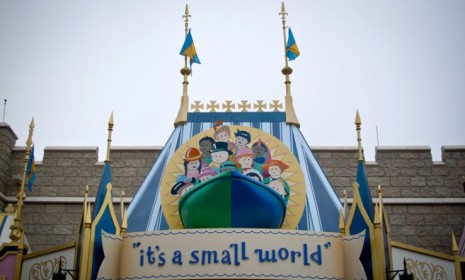'It's a Small World': The world's most annoying song?
Repetition, musical simplicity, and incongruity have a lot to do with why the famous Disney tune is so irritating, says Jason Richards in The Atlantic

If you've ever visited one of the five Disney theme parks around the world, chances are you've heard a continuous loop of the song "It's a Small World (After All)" and found it vexing, says Jason Richards in The Atlantic. The song, written in 1964 by Robert B. Sherman (who died March 4), was calculated to be both easy to sing in different languages and uniquely unforgettable — which may be why it has so often "gotten on people's nerves," writes Richards. "It's a Small World" is "a common 'earworm,' a piece of music that can easily get lodged in the auditory cortex." In this excerpt, Richards explains why the song has become such a bugaboo:
James J. Kellaris, a marketing professor at the University of Cincinnati, has done extensive research on what makes certain songs get stuck in the head. His theory is that music can create a "cognitive itch—the mental equivalent of an itchy back," especially when three qualities are present: repetition, musical simplicity, and incongruity.
No one would argue that "It's a Small World (After All)" isn't simple or repetitive. The word "world" appears 14 times in the 22 English lines of the song....
The Week
Escape your echo chamber. Get the facts behind the news, plus analysis from multiple perspectives.

Sign up for The Week's Free Newsletters
From our morning news briefing to a weekly Good News Newsletter, get the best of The Week delivered directly to your inbox.
From our morning news briefing to a weekly Good News Newsletter, get the best of The Week delivered directly to your inbox.
As for incongruity, one could point to the cheerful young singers of "It's a Small World (After All)"... "Children's music is difficult for grown-ups, a lot of the time. It's really meant to appeal to things that a childish sensibility enjoys," said Carl Wilson, a music critic from Toronto and the author of Let's Talk About Love: A Journey To The End of Taste. "And for grown ups, that can be maddening, especially when you've been exposed to that your entire life. 'It's a Small World' is way better than the Barney song, for example, and the Barney song practically makes adults run screaming from the room because it's so specific to what a toddler likes."
Read the entire article in The Atlantic
A free daily email with the biggest news stories of the day – and the best features from TheWeek.com
-
 The Trump administration says it deports dangerous criminals. ICE data tells a different story.
The Trump administration says it deports dangerous criminals. ICE data tells a different story.IN THE SPOTLIGHT Arrest data points to an inconvenient truth for the White House’s primary justification for its ongoing deportation agenda
-
 Ex-FBI agents sue Patel over protest firing
Ex-FBI agents sue Patel over protest firingspeed read The former FBI agents were fired for kneeling during a 2020 racial justice protest for ‘apolitical tactical reasons’
-
 The real tragedy that inspired ‘Hamlet,’ the life of a pingpong prodigy and the third ‘Avatar’ adventure in December movies
The real tragedy that inspired ‘Hamlet,’ the life of a pingpong prodigy and the third ‘Avatar’ adventure in December moviesThe Week Recommends This month’s new releases include ‘Hamnet,’ ‘Marty Supreme’ and ‘Avatar: Fire and Ash’